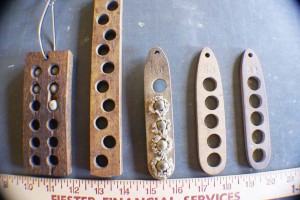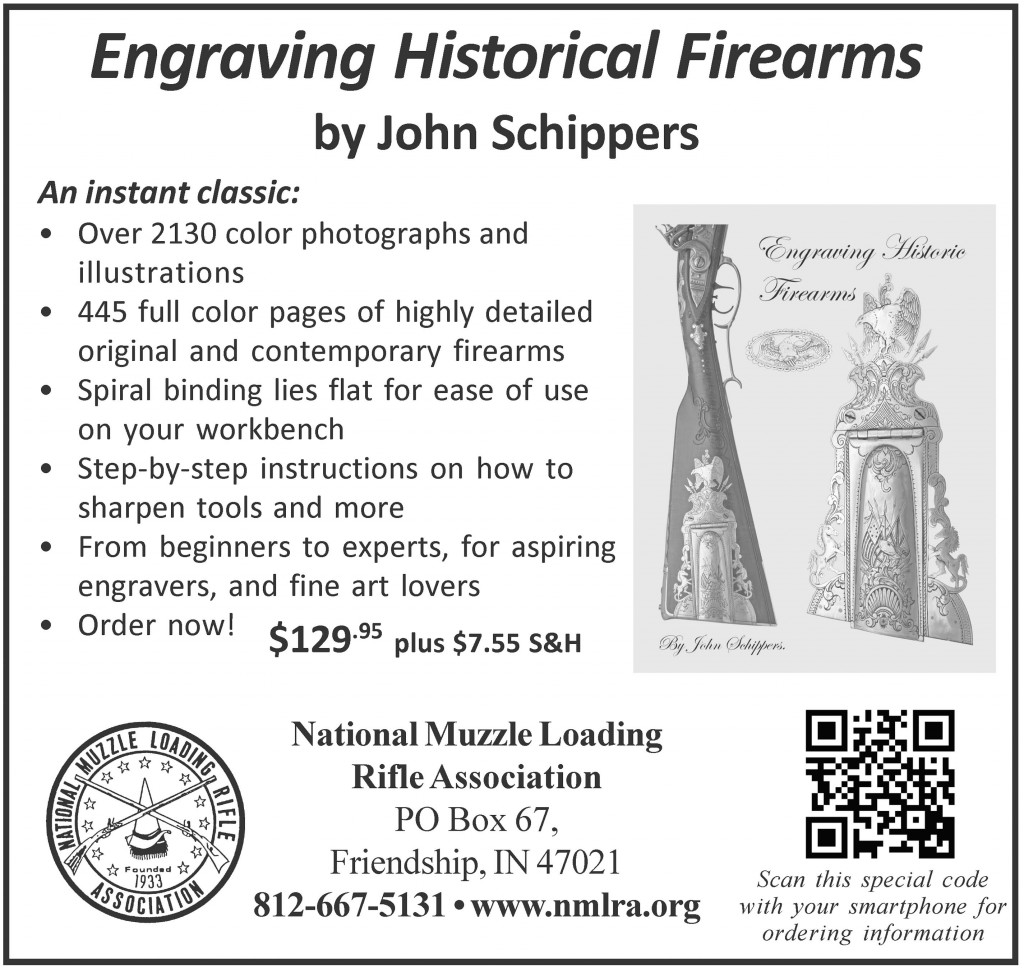by James C. Fulmer | Past President, NMLRA
November is the time of the year when the hunting begins. Whether hunting for an honest politician at the voting booth or hunting for game animals, this is the time of the year these great events take place. Both need to have the same skill levels. You need to have the knowledge of what you are hunting. The difference is when you harvest a squirrel, rabbit, pheasant, or deer you know what you have immediately for the cook pot. When voting for a politician, it takes about two years to identify what you have—and it takes another two years to correct your mistake if the politician turned out to be something you weren’t hunting.
 Hunting with a muzzleloader is my favorite type of hunting. The limitations of the single shot—or two if using a double barreled muzzleloader—add to the hunt. I use a muzzleloader for both small and large game. In Pennsylvania, we can use a .40 caliber or less muzzleloading rifle for small game and .45 caliber or bigger for large game; muzzleloading shotguns cannot be larger than 10 gauge.
Hunting with a muzzleloader is my favorite type of hunting. The limitations of the single shot—or two if using a double barreled muzzleloader—add to the hunt. I use a muzzleloader for both small and large game. In Pennsylvania, we can use a .40 caliber or less muzzleloading rifle for small game and .45 caliber or bigger for large game; muzzleloading shotguns cannot be larger than 10 gauge.
I target shoot year around with my muzzleloaders. I spent almost all of one year sighting in a deer rifle I had put together at matches. I can’t say I made it, but what I put together was a Thompson/Center Hawken stock with a Getz .54 cal. barrel I cut to 34 inches, with an added under rib and a drop-in L & R flintlock. Wow, does it shoot! For hunting deer I use 80 gr. of FFg blackpowder with a patched round ball. Many people will ask me what loads I use for deer. It is no secret and most books and manufacturers recommend the same loads. For a .45 cal., I use 70 gr. FFFg blackpowder and for a .50 cal. I use 80 gr. FFg blackpowder. I don’t hunt with my .58 cal. copy of an 1863 Remington Zoauve rifled musket much anymore, but I did use only 70 gr. FFg blackpowder with a Minnie ball. My smoothbore, which is a copy of a 1763 Charleyville, is a .69 cal. and I used 90 gr. of FFg blackpowder. Other than the rifled musket, I use all patched round balls.

Some typical hardwood loading blocks drilled for specific calibers, left to right: 45, 50, 54, 58 and 62 calibers.
I get asked a lot what caliber to use for deer. I say the same thing to everyone—bigger is better with a round ball. If you are a one gun person, the .50 caliber is perfect. It is good for both target and big game. But if it is just for deer and occasional target shooting, I like the .54 cal. rifle. Energy is what it takes to harvest a deer. Back in the early 1970’s when all of the new muzzleloading seasons were starting in different states, the American Hunting Institute established that 500 foot pounds of energy was needed to penetrate 11 inches of vital organs on a mature whitetail deer. To give you an idea, many deer in Pennsylvania have been taken using a .45 cal. which generates about 500 foot pounds at 50 yards with a 127-gr. round ball. The .50 cal. dramatically increases to 725 foot pounds at 50 yards with its 175-gr. round ball. The .54 cal. is 850 foot pounds at 50 yards using a 230-gr. round ball. Energy is generated by velocity (more powder) or bigger ball. The 100-gr. difference between a .45 caliber and a .54 caliber round ball is something to think about when going after big game.
When it comes to learning and reading up on the whys and wherefores of hunting big game, a great reference book anybody who hunts should have is Muzzleloading for Deer & Turkey by Dave Ehrig. It has all the charts and recommended loads for round ball and sabots and explains why. It also has a lot of shotgun information for turkeys, with all of the whys explained.
Hunting is totally different than target shooting. I know—I am a target shooter who struggles with hunting. I have shot a few deer over the years with a muzzleloader: 7 bucks and numerous does. The difference is that when target shooting with a muzzleloader you have 20 to 30 minutes to get 5 shots off in competition. In hunting you have only seconds sometimes to find a front sight, settle in, and shoot. For me it helped when I started using a rifle for hunting only with easy to find and locate sights for a quick sight picture. When you look at an original muzzleloader you will see sights that are low with a very shallow notch in the rear sight. Either you see the sight or you don’t—there is no hunting for the sight picture.
If you go to rifle matches with your muzzleloader, do the woods walks. There you will learn the world is not made of round targets that are shot on even ground. Woods walks are made for hunting situations—uneven ground, various distances, odd shaped targets, and loading out of a bag. To speed this process I use loading blocks. A loading block is a piece of wood drilled to size to hold your cloth patched round-ball; they can even hold saboted bullets. They are historically correct and are easy to make yourself. They come in all sizes. During the American Revolution 3 to 5 ball loading blocks were common. Bags have been found with 3 blocks of 3 round balls. The thought was that if you drop a block, you didn’t lose all of your shots. I make most of mine as 5 shots and even 12 shots. During events where I prefer to load out of a block I will load up 5 blocks of 12 and be good for the weekend.
 The size drill bit you need to make your bullet block may vary some because of the wood, how it’s drilled, and your patch ball combination. Any hardwood will work, some are better than others due to splintering. When you drill the holes, maple is my first choice, and I use a lot of oak because I can get it easily, but it does want to splitter out the back if you hurry on your drilling. I use a 27/64 drill for .40 cal., 15/32 drill for a 45 cal., 17/32 drill for a .50 cal., and a 9/16 for a .54 cal. Basically you want to find a drill bit that is roughly .020 bigger than the caliber. The other important thing you need to do with a bullet block is make sure you soak the block with the lubricant you use on the patch or soak it with some type of oil because the untreated wood will suck the lubricant out of your bullet patch. Bullet blocks are also commercially available and as inexpensive as they are, you may want to buy your blocks.
The size drill bit you need to make your bullet block may vary some because of the wood, how it’s drilled, and your patch ball combination. Any hardwood will work, some are better than others due to splintering. When you drill the holes, maple is my first choice, and I use a lot of oak because I can get it easily, but it does want to splitter out the back if you hurry on your drilling. I use a 27/64 drill for .40 cal., 15/32 drill for a 45 cal., 17/32 drill for a .50 cal., and a 9/16 for a .54 cal. Basically you want to find a drill bit that is roughly .020 bigger than the caliber. The other important thing you need to do with a bullet block is make sure you soak the block with the lubricant you use on the patch or soak it with some type of oil because the untreated wood will suck the lubricant out of your bullet patch. Bullet blocks are also commercially available and as inexpensive as they are, you may want to buy your blocks.
Hunting is an important part of our muzzleloading sport and it is important to mentor the youth to hunt as well as their parents. Take a young person hunting whether it is your children, grandchildren, the neighbor’s children, or your neighbor. But just as important to our sport this month is to get out and vote. Make sure you mentor the same people on the need to vote. It is just as important to teach a person about the importance of and need to vote. Vote this November!




